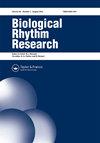夜猫子和孤狼
IF 0.9
4区 生物学
Q3 BIOLOGY
引用次数: 2
摘要
摘要:白天更喜欢晚上的时间与较差的身心健康状况有关。在目前的报告中,在一个大样本(N=4684)的早晚型个体中,对感知到的孤独感和大脑结构(海马和杏仁核体积)进行了比较。明确的夜晚与报告自我感觉孤独的几率增加有关,与早晨和社交联系更紧密的夜晚类型相比,孤独的夜晚类型的右海马体积明显更小。这些数据增加了越来越多的证据,将晚间情况与精神障碍风险增加联系起来。本文章由计算机程序翻译,如有差异,请以英文原文为准。
Night Owls and Lone Wolves
ABSTRACT Diurnal preference for evening time has been associated with poorer physical and mental health outcomes. In the current report, perceived loneliness and brain structure (hippocampal and amygdala volumes) were compared in a large (N = 4684) sample of morning- and evening-type individuals. Definite eveningness was associated with increased odds for reporting self-perceived loneliness and lonely evening-types had significantly smaller right hippocampal volume as compared to morning and more socially connected evening types. These data add to the mounting body of evidence linking an evening profile with increased risk for psychiatric disorder.
求助全文
通过发布文献求助,成功后即可免费获取论文全文。
去求助
来源期刊

Biological Rhythm Research
生物-生理学
CiteScore
3.00
自引率
9.10%
发文量
34
审稿时长
6-12 weeks
期刊介绍:
The principal aim of Biological Rhythm Research is to cover any aspect of research into the broad topic of biological rhythms. The area covered can range from studies at the genetic or molecular level to those of behavioural or clinical topics. It can also include ultradian, circadian, infradian or annual rhythms. In this way, the Editorial Board tries to stimulate interdisciplinary rhythm research. Such an aim reflects not only the similarity of the methods used in different fields of chronobiology, but also the fact that many influences that exert controlling or masking effects are common. Amongst the controlling factors, attention is paid to the effects of climate change on living organisms. So, papers dealing with biometeorological aspects can also be submitted.
The Journal publishes original scientific research papers, review papers, short notes on research in progress, book reviews and summaries of activities, symposia and congresses of national and international organizations dealing with rhythmic phenomena.
 求助内容:
求助内容: 应助结果提醒方式:
应助结果提醒方式:


